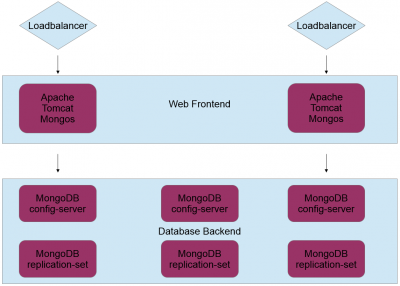Servers
| Server
|
Software
|
Operating system
|
Resources
|
| prod-ocid-web-01.colt.enaikoon.de
|
Apache + Tomcat + MongoS
|
Ubuntu 12.04 LTS
|
2 vCPU, 4 GB
|
| prod-ocid-web-02.colt.enaikoon.de
|
Apache + Tomcat + MongoS
|
Ubuntu 12.04 LTS
|
2 vCPU, 4 GB
|
| prod-ocid-cfgsrv-01.colt.enaikoon.de
|
MongoDB ConfigServer
|
Ubuntu 12.04 LTS
|
1 vCPU, 2 GB
|
| prod-ocid-cfgsrv-02.colt.enaikoon.de
|
MongoDB ConfigServer
|
Ubuntu 12.04 LTS
|
1 vCPU, 2 GB
|
| prod-ocid-cfgsrv-03.colt.enaikoon.de
|
MongoDB ConfigServer
|
Ubuntu 12.04 LTS
|
1 vCPU, 2 GB
|
| prod-ocid-db-01.colt.enaikoon.de
|
MongoDB Replication Set
|
Ubuntu 12.04 LTS
|
4 vCPU, 48 GB
|
| prod-ocid-db-02.colt.enaikoon.de
|
MongoDB Replication Set
|
Ubuntu 12.04 LTS
|
4 vCPU, 48 GB
|
| prod-ocid-db-03.colt.enaikoon.de
|
MongoDB Replication Set
|
Ubuntu 12.04 LTS
|
4 vCPU, 48 GB
|
Software stack
Operating System
All OpenCellID servers are running with Ubuntu Linux 12.04 LTS.
Frontend
- the web frontend uses Apache web server as a proxy for serving web requests to Tomcat
- the OpenCellID web application is running on Tomcat and is reading and writing cell measurement data to/from the MongoDB database backend
- jQuery Mobile is responsible for providing a cross-platform user interface
- the map is displayed using OpenStreetMap combined with Leaflet library
Database Backend
The OpenCellID backend uses Kafka queuing system in order to be able to handle periodic peaks. Kafka producers embedded into the web application send all incoming data to Kafka brokers. Kafka consumers pull data from brokers, process measurements and store them in MongoDB.
The database backend, with a current 7 million cell towers and about 1.2 billion measurements (1.1.2015), is a MongoDB database cluster with six servers:
- three servers are serving as MongoDB configuration servers and Zookeeper instances
- the other three servers are serving as the database backend with one replication set spread across the three servers and Kafka brokers
Challenges and solutions
The OpenCellID community is very strong and continuously provides a high number of measurements.
This immediately poses a few challenges:
- High Volume
data arrives from many different sources and is rapidly growing
- Scale
growth of data should go along with predictable, incremental costs and no downtime should be needed when adding additional server resources
- Data Processing
the analysis and process of the rapidly growing data must be constantly efficient
The current solutions are based on Kafka queuing system and MongoDB with its features:
- Native Analytics
using the integrated aggregation framework and Map/Reduce to calculate aggregates and analyses in place without the need of prior exporting data to other systems
- Advanced Geo Queries
using geospatial MongoDB support to execute complex queries
- Horizontal Scaling
sharding makes it easy to scale applications horizontally on commodity hardware for accommodating constantly increased throughput
- Reduced Total Cost of Ownership (TCO)
as open-source storage MongoDB and Kafka queuing system are a very cost-effective solution
The brain
Krzysztof Ociepa (email: [email protected]) has designed the big-data infrastructure as well as the new OpenCellID server software based on Java, Kafka queuing system and MongoDB, and has also implemented most of the current features after two other developers failed to do so.
Details about the implemented software and infrastructure can be found above.
There are plans to publish the entire server software as open source for stimulating the contribution of software features of other community members of the OpenCellID project. This will most likely happen before the end of 2015.
| 